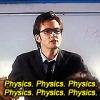The Big Bang Theory Season 3 Episode 10: "The Gorilla Experiment"
Yes, I'm adding another show! The other day I was watching a newer episode of the Big Bang Theory when I realized that there could be some good things to talk about in this show. After a bit a research, I was definitely right about that.
So let's start here:
So, Sheldon- a super smart astrophysicist- is trying to teach Penny- an average human with no knowledge of physics- about some basic physics concepts.
One such concept is Newton's equations for gravity and gravitational force, or Newton's Law for Universal Gravitation. I should start this by saying that he his referring objects falling a vacuum, not in regular space. The equation he writes on the board is Fg=(GMm)/(r2), where G= universal gravitation constant (6.67x10-11), M=mass of the planet, m=mass of the object, and r=radius of orbit. We also know from Newton's Second Law that Fg=ma, where m=mass of the object and a=acceleration of the object. Setting those equal to one another, since both are equation to Fg, yields the following.
(GMm)/(r2)= ma => a=(GM)/(r2) => a=g
But wait, there's more! Another known concept is that g= (GM)/(r2), where g is the acceleration due to gravity on a given planet (usually Earth). So lets add that above (see the bold letters).
Once he works this out, Sheldon asks Penny what this means we know. For one, it means that the object is accelerating towards the planet's center of gravity (downward) since it is being acted on by the force of the planets gravitational field. It also means that the object is accelerating due to the force of gravity of the planet it is on or above and that this acceleration is uninterrupted. If a=g exactly there are no other forces on the object as it accelerates. An force in the upward direction (opposite the acceleration) would slow down (decrease) the acceleration of the object and added downward force would increase. Therefore if a=g, there is no other forces besides the force of gravity acting on the object. This can happen because the object is considered to falling in vacuum, which means that mass and size don't affect acceleration, there are no other forces acting on the object and thus a=g is possible.
Ok! So there's some pretty neat, albeit basic, uses for some of Sir Isaac Newton's laws. Other than that, enjoy the rest of the clip (its quite funny) and thanks for reading!



0 Comments
Recommended Comments
There are no comments to display.